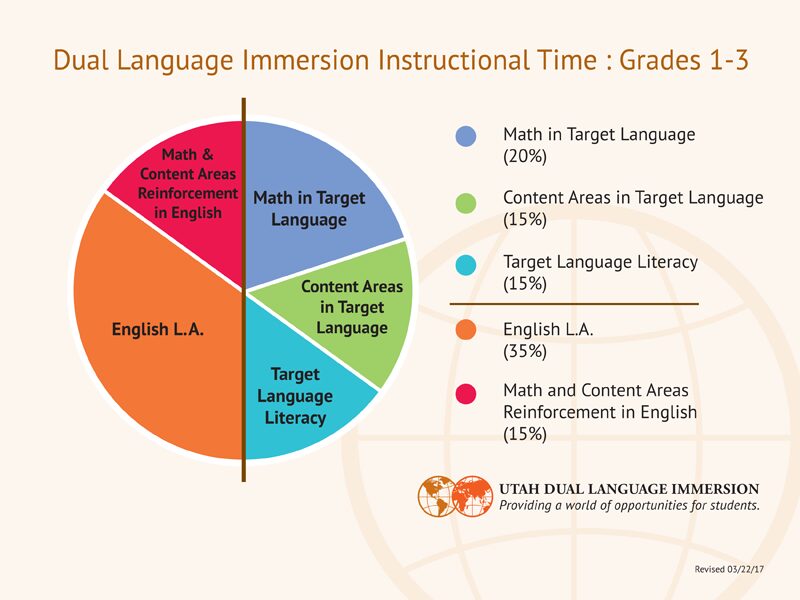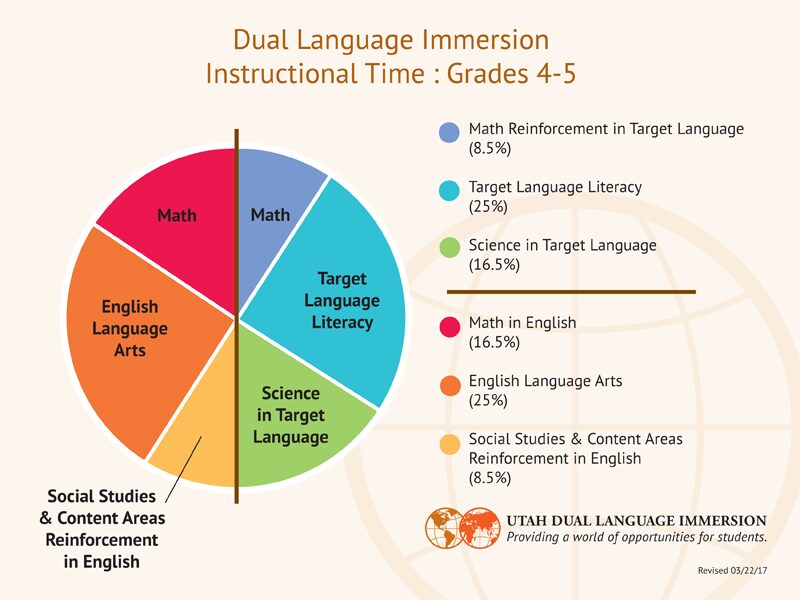Dual language immersion program models
What are the typical curricular models for dual language programs?
By Johanna Watzinger-Tharp, Ph.D.
Dual language, or dual immersion education in the U.S. refers to formal schooling in two languages, typically starting in Kindergarten or first grade and, ideally, sustained and articulated through grade 12. Dual immersion programs may be offered whole school, or as a strand within a school. Generally speaking, elementary dual immersion is well defined and has experienced rapid growth over the past 10 years, while secondary dual immersion programs are relatively rare and not as well defined.Even though dual immersion programs vary according to contexts, implementation and structure, they share three common goals: bilingualism and biliteracy; academic achievement in both languages; and biculturalism, or the understanding and appreciation of multiple cultures and languages (U.S. Department of Education, Office of English Language Acquisition, Dual Language Education Programs: Current State Policies and Practices, Washington, D.C., 2015). In dual language programs, students learn core subjects (English language arts, math, science) in English and a partner language (also called target language), for example Chinese, French or German. Dual language programs are designed to serve all students, including those whose home language is not English, students with special needs and students from lower socioeconomic backgrounds. They also serve students whose home language is neither English nor the partner language, for example a student with a French home language background who might participate in a German/English dual immersion program.
Instructional models: Elementary dual immersion
Instructional models for dual immersion vary within and across educational levels (elementary, middle and high school). Moreover, specific features of an instructional model, for example which subjects are taught in which language, may change from one grade level to another. Programs do have to align with certain principles to be classified as dual immersion. Most importantly, at least 50% of the school day must be taught in the partner language, though teachers may enforce students’ use of the partner language to a greater or lesser degree, depending on grade level and proficiency.
Programs range from an equal 50/50 language allocation (half of the day in each language) to 90/10 models where students are taught almost exclusively in the partner language, e.g. German, French or Spanish. The 90/10 allocation gradually shifts toward an even split, usually by grade 5. 50/50 program models almost always involve two teachers, and two classrooms, one for the partner language and the other for English. 90/10 models, in contrast, typically rely on a single bilingual teacher who switches from one language to the other at specified times of the school day. It is important to note that the partner language content is not repeated or duplicated in English. Rather, content, materials and instruction have to complement each other, since the length of the school day, and the amount of time available for learning, is the same for children in dual language immersion as it is for children in monolingual classrooms.
Instructional model illustration: Utah dual immersion
The two pie charts below illustrate the decisions pertaining to the distribution of subjects that schools have to make by showing the instructional model for dual language programs in the State of Utah. In Utah schools, in grades 1-3, content areas such as math, social studies and science are taught in a partner, or target language, for example German (shown as the right half of the pie chart). The other (equal) part of the day (shown as the left half of the pie chart) is mostly devoted to English literacy, or English language arts. During the English-speaking part of the school day, students also learn English vocabulary to reinforce content that is taught in the target language, in particular math. In grades 4-5, math mostly shifts to the English portion of the day, English language arts decreases, and the amount of target language literacy instruction increases.
Secondary Dual Immersion
Sustaining dual language immersion into middle and high school is critical to students achieving high levels of proficiency in both English and the partner language, but also presents significant challenges. It is difficult to meet the need for teachers who are qualified to teach secondary content areas in a language other than English, though elementary schools often face a teacher shortage as well. Generally speaking, secondary programs tend to be less rigorously defined, not as structured and also less likely to divide instruction equally across the two languages. Given the challenges, it is unfortunately quite common for school districts to discontinue dual language immersion after 6th grade.
What are the options or models, then, for continuing dual language immersion through middle and high school? Most commonly, middle and high schools will offer one, possibly two content courses, e.g. history, math or social science, and a language arts course that is geared to the level of students who have experienced five to six years of dual immersion. With these limited course offerings, the allocation of partner language instruction will be much less than 50%, possibly 40%, but more likely 25-30%.
In schools with an Advanced Placement (AP) program, students who have continued with some form of dual language immersion at the secondary level are often able to complete an AP world language course and exam as early as 9th grade. This opportunity also creates another challenge, however, since schools rarely offer world language or language arts courses beyond AP. The State of Utah is addressing this issue with the so-called Bridge Program for grades 10, 11 and 12. Through partnerships with universities, high schools offer advanced courses that grant high school and upper level college credits to students who have passed the AP exam.
Conclusion
For students to reach advanced levels of proficiency in two languages, they must have the opportunity to participate in articulated dual immersion programs from kindergarten or first grade through 12th grade. The creation of dual immersion programs at the elementary level should always go hand-in-hand with planning for secondary level continuation that includes setting proficiency targets and benchmarks for each grade level. Only well-articulated and rigorously designed K-12 dual immersion programs will create the conditions necessary for students to become truly bilingual, biliterate and bicultural.
Johanna Watzinger-Tharp, Ph.D. is associate professor in the Department of Linguistics at the University of Utah, researching and teaching on dual immersion, multilingualism, curriculum design and teacher education.


